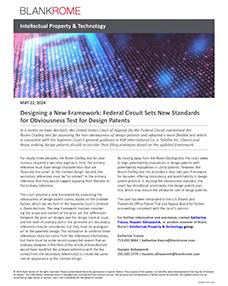Designing a New Framework: Federal Circuit Sets New Standards for Obviousness Test for Design Patents
In a recent en banc decision, the United States Court of Appeals for the Federal Circuit overturned the Rosen-Durling test for assessing the non-obviousness of design patents and adopted a more flexible test which is consistent with the Supreme Court's general guidance in KSR International Co. v. Teleflex Inc. Clients and those seeking design patents should reconsider their filing strategies based on the updated framework.
For nearly three decades, the Rosen-Durling test for obviousness required a two-step approach. First, the primary reference must have design characteristics that are “basically the same” as the claimed design. Second, the secondary references must be “so related” to the primary reference that they would suggest applying their features to the primary reference.
The court adopted a new framework for evaluating the obviousness of design patent claims, based on the Graham factors, which are set forth in the Supreme Court’s Graham v. Deere decision. The new framework involves considering the scope and content of the prior art, the differences between the prior art designs and the design claim at issue, and the level of ordinary skill in the pertinent art. Secondary references may be considered, but they must be analogous art to the patented design. The motivation to combine these references need not come from the references themselves, but there must be some record-supported reason that an ordinary designer in the field of the article of manufacture would have modified the primary reference with the feature(s) from the secondary reference(s) to create the same overall appearance as the claimed design.
By moving away from the Rosen-Durling test, the court seeks to align patentability evaluations in design patents with patentability evaluations in utility patents. However, the Rosen-Durling test has provided a clear two-part framework for decades, offering consistency and predictability in design patent practice. In revising the obviousness standard, the court has introduced uncertainty into design patent practice, which may reduce the allowance rate of design patents.
The case has been remanded to the U.S. Patent and Trademark Office Patent Trial and Appeal Board for further proceedings consistent with the court's opinion.
For further information and assistance, contact Katherine Franco, Hussein Akhavannik, or another member of Blank Rome’s Intellectual Property & Technology group.


